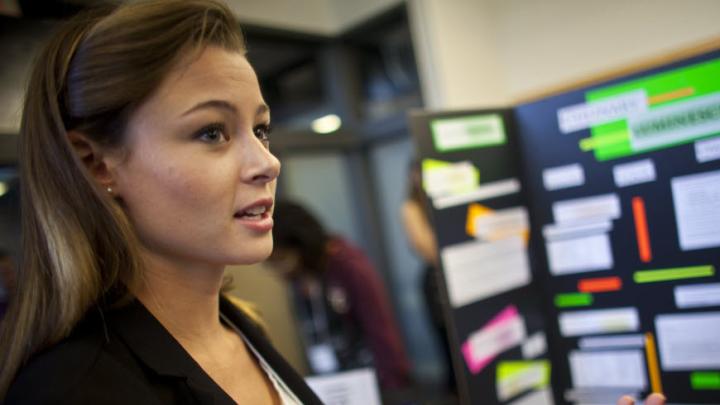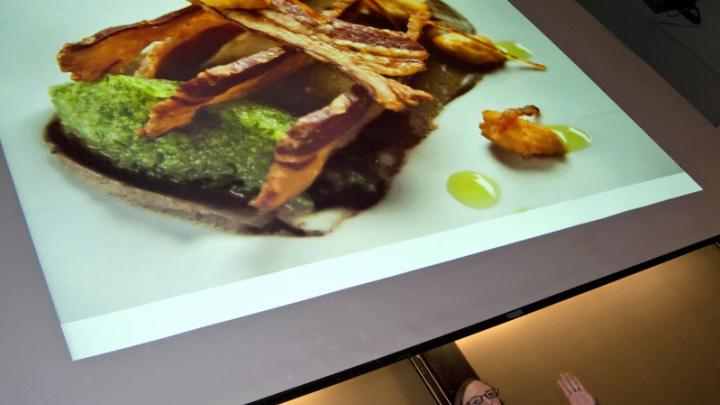The students in Science of the Physical Universe 27: "Science and Cooking: From Haute Cuisine to Soft Matter Science" had just burst into applause. In this moment, they weren't clapping because Jose Andrés had made an egg out of cheese or because Grant Achatz had passed out powdered caramel that turned into chewy caramel into your mouth--both of which did happen in the class, by the way--but because Professor Michael Brenner had just unveiled the equation of the week: a heat transfer equation. The applause became a tradition in the course, each time an equation of the week was displayed; this particular one described how heat moves through a body, and students would later use it to calculate how long, and at what temperature, to cook a molten chocolate cake to get that characteristic gooey center with a fully baked crust.

Enthusiasm for equations notwithstanding, it was "haute cuisine," not "soft matter science," that initially drew most of the students to SPU 27, a new course this fall taught by David Weitz (Mallinckrodt professor of physics and of applied physics) and Michael Brenner (Glover professor of applied mathematics and applied physics) in collaboration with Fundación ALICIA, the foundation of El Bulli chef Ferran Adrià, one of the most famous chefs in the world. Even by Harvard standards, the class had a special dose of celebrity glamour. The course's first lecture, to which 700 students showed up for 300 spots, unveiled a lineup of guest lecturers including Adria, wd~50's Wylie Dufresne, and Momofuku's David Chang. The lecture slides featured slick chef portraits reminiscent of ads for Top Chef. By the second lecture, students were lining up in the Science Center half an hour before class. Mid semester, just as the buzz about the course was starting to level off, it was announced that the grand prize for the course's final project contest would be a trip to Barcelona in January.
If SPU 27 captured the attention of Harvard undergraduates, it captured the attention of the media, too. The New York Times featured it in its science section, the Boston Globe ran a multipart series, and even the recent Ferran Adrià biography mentioned the course. Each visiting chef also gave an evening lecture that was open to the public; to gain admittance, arriving an hour early was recommended.
"I never dreamed the course would be as successful or as popular as it was," said Weitz. As big as SPU 27 became, it all started as an idea about teaching science to people who would have skipped right past a course whose title included "soft matter science." (The term applies to the study of any materials that are not simple crystalline solids or simple liquids. This category includes foams, gels, and polymers—of the culinary variety, or not.)
When Otger Campàs, a postdoctoral fellow in Brenner's lab, first approached Weitz about bringing Ferran Adrià to Harvard as part of a public lecture series in 2008, the response was skeptical. "I said, 'You can invite him, but he'll never come. Do you know who Ferran Adrià is?' " said Weitz. But Adrià did come, and the resulting mob at his talk foreshadowed the first day of class for SPU 27.
With that enthusiasm in the community, plans for the class were drawn up the very next day. The final structure of course was a lab and two 90-minute lectures per week: a lecture on scientific concepts and a guest lecture by a chef applying those concepts to cooking. Fundación ALICIA and its head of gastronomic and scientific research, Pere Castells, arranged the line-up of guest chefs. Brenner emphasized that the class was conceived from the very beginning as part of Harvard's recently launched General Education curriculum. Designing a class for nonscience concentrators, of course, posed its own set of challenges.
"Teaching something like soft matter physics--there is no textbook for undergrads. It's normally taught in graduate studies. Teaching that for nonscience students is not easy at all," said Campàs.
The bookshelf in Brenner's office is full of the physics and math textbooks familiar to any Harvard science student. On his desk, however, were cookbooks by Achatz, of Alinea, and Heston Blumenthal of The Fat Duck. These books had glossier photos, but the recipes were as precise as notes in a lab notebook. "What these chefs are doing is basically sophisticated material manipulation," said Brenner. "This is squarely in our science of soft matter."
With help from the foundation and Castells, who has a background in chemistry, Brenner, Weitz, Campàs, and postdoctoral fellow Amy Rowat sat down to write the syllabus for the course. Over the spring semester, a team of teaching fellows made up of science graduate students put together the homework and labs. They held lab-testing "dinner parties," many of them in the kitchen of teaching fellow Benjamin Miller's parents. A heat-diffusion experiment that involved baking tofu was the inspiration for an ultimately tastier molten-chocolate lab. The TFs also took a trip to wd~50 in New York City to learn about shrimp noodles, which became another course lab.
On a monday afternoon in November, the aroma in the Northwest Science Building, room 143, was changing from sweet boiling milk to the savoriness of sesame oil. The students had finished making caramel (a demonstration of caramelization and the Maillard reaction—a reaction between protein and sugar that produces browning and is not well understood even by scientists). They were moving on to shrimp noodles. The key to shrimp noodles (literally noodles made of shrimp meat) is an enzyme called transglutaminase, also known as "meat glue." Transglutaminase links together protein molecules, so that bits of ground-up shrimp can be ejected from a syringe into a water bath to make noodles.
In theory, anyway. In practice, the shrimp noodles were disintegrating and the constant-temperature water baths rather resembled dirty aquarium tanks. Miller admitted that this was one of the trickier labs. Wylie Dufresne has shrimp oil and a Japanese noodle press in his kitchen; the SPU 27 lab has sesame oil and syringes. While the caramels had all gone smoothly, the shrimp noodles were proving more elusive.
A diagram on the whiteboard explained how transglutaminase links proteins, but the students and TFs were figuring out why it didn't seem to be working. Memorizing equations and diagrams, like memorizing recipes in cooking, can take one only so far (the reason the hands-on experience of labs is so integral to teaching science).
The labs in SPU 27 have a unique twist: the results are edible. It was a stroke of luck that this lab in the basement of the new Northwest Building had never been used—hence, contamination from previous experiments was not a concern. Whole Foods, one of the course's corporate sponsors, donated food; for a lab on ceviche, sashimi-grade tuna was ordered specifically for the class. Other ingredients came from Restaurant Depot—like Costco, but for restaurant supplies. The whiteboards in the lab open to reveal a pantry containing the usual suspects—olive oil, salt, sugar—plus some harder-to-pronounce ingredients: alginate, xanthan gum.
(Besides Whole Foods and Fundación ALICIA, other sponsors included the ThinkFood Group, Le Creuset, Cole-Parmer, the ESADE Business School at Ramon Llull University, Mars North America, and the Office of the Senior Vice Provost for Faculty Development and Diversity.)
The shrimp noodles were ultimately made successfully by doubling the transglutaminase. For the few curious students who sampled them, though, the caramel still won out in taste.
As engrossed as the students were in their labs, the mood of the class shifted when Dufresne, inventor of the shrimp noodles, walked into the room. A group of students (vegetarians who skipped the shrimp-noodle experiment) was working on their final project, also involving transglutaminase and also inspired by Dufresne. Dufresne had wanted to serve pasta carbonara using noodles made of parmesan in his restaurant, but was having trouble making parmesan noodles that could be heated and still retain the right texture.
Though transglutaminase is known as "meat glue," it can actually act on any protein. To use it when there is not enough protein in the original food, one can add gelatin, which is how the parmesan noodles were being made. The group had just, for the first time, successfully made the parmesan into noodles using a wd~50 recipe, but the texture—rubbery from the gelatin—left a little to be desired. Dufresne consulted with the students about their project and also suggested an alternative method of rolling out the noodles.
When Dufresne left, the tense murmur of students trying not to make a big deal out of his presence, even though it was kind of a big deal, also disappeared. "Can we go take a picture with him?" giggled a pair of them, glancing at the door.
Celebrity always has this potential to distract, but the chefs for SPU 27 have been an integral part of the course rather than just marquee names. That students' final projects, such as the parmesan noodles, were tackling real problems from the kitchens of these chefs speaks to the spirit of collaboration. Chefs also held office hours, where some fielded questions and others made edible creations. Spanish chocolatier Enric Rovira used bittersweet Valrhona chocolate to construct a chocolate house, eggs, and other creations during his office hours, demonstrating the possibilities when using tempered chocolate (as opposed to untempered chocolate, which is crumbly and dull).
Weitz emphasized that ultimately, "This was designed as science course. The whole curriculum was dictated by science and not by cooking." Both Brenner and Weitz marveled that the chefs were committed to teaching the science in their guest lectures, when they could have easily just showed off their latest culinary creations. Carme Ruscalleda, a chef with five Michelin stars, devoted her lecture to the very basic cooking process of browning reactions.
There was still some ambivalence about the outpouring of media attention for the course. Brenner particularly didn't want the course fair, where all the final projects were to be presented and judged, to become a media attraction. "I want it to be about the students," he said.
The projects at the fair applied science to initially mind-boggling food creations. There were glow-in-the-dark gummy bears, unmeltable chocolate, edible candy wrappers. The group making parmesan noodles had perfected their procedure so that their noodles no longer turned out rubbery.
Harold McGee, whose seminal book On Food and Cooking was the course's required text, stopped to chat with students Jason Alexander Varnell, a junior concentrating in chemistry, and Anh Marie Le, a junior history and literature concentrator, about their project: using soy protein and transglutaminase to glue together two apple halves—one red, one green—to make a "hybrid apple." "It was a little surreal," said Le after explaining the science of transglutaminase to McGee himself. "I kept thinking back to his book."
Accompanying the samples of food were charts and graphs explaining the experimental process for each group. Students at the fair donned aprons printed with "equations of the week" from the course. "The sort of amazing thing," said Brenner, "is that what happened is that hundreds of students who under normal circumstances would not have been interested in science were interested in this."
After the grand prize was awarded to two groups--one that made gluten-free pasta and another that made soup stock that stayed solid at a high temperature--the last items given out at the fair were for Brenner. "He's not a fancy guy," said Weitz—even if Brenner had just taught a class with "haute cuisine" in the title. Weitz handed Brenner a backpack and a bicycle helmet. Emblazoned in reflective ink on the helmet was every single equation of the week.












